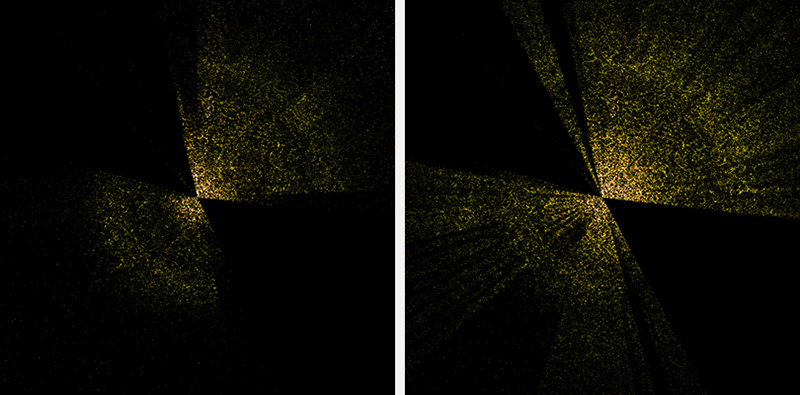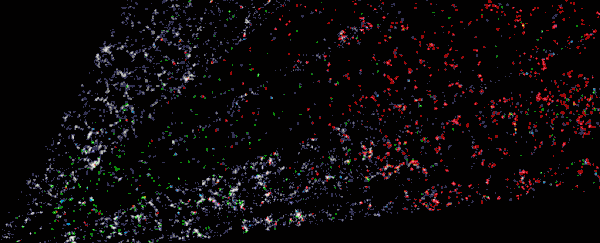The Dark Energy Spectroscopic Instrument (DESI), currently pointed at the skies from its home in the Nicholas U. Mayall Telescope at the Kitt Peak National Observatory in Arizona, is tasked with charting the expansion of space, investigating dark energy, and creating the most detailed 3D map of the Universe that's ever been put together.
It's only been seven months into DESI's mission and we already have a record-breaking, jaw-dropping, three-dimensional picture of the galaxy that's all around us, proving the capabilities of DESI and the potential it has for mapping space.
DESI has already cataloged and charted more than 7.5 million galaxies, with more than a million new ones being added per month. By the time the scan comes to a complete end in 2026, it's thought that over 35 million galaxies will have been mapped, providing astronomers with a huge library of data to mine.
"There is a lot of beauty to it," says astrophysicist Julien Guy from the Lawrence Berkeley National Laboratory in California.
"In the distribution of the galaxies in the 3D map, there are huge clusters, filaments, and voids. They're the biggest structures in the Universe. But within them, you find an imprint of the very early Universe, and the history of its expansion since then."
DESI is made up of 5,000 optical fibers, each individually controlled and positioned by its own tiny robot. These fibers have to be accurately positioned to within 10 microns, or less than the thickness of a human hair, and they then capture glimpses of light as they filter down to Earth from the cosmos.
Through this fiber network, the instrument takes color spectrum images of millions of galaxies, covering more than a third of the entire sky, before calculating how much the light has been redshifted – that is, how much it's been pushed towards the red end of the spectrum due to the expansion of the Universe.
As this light can take up to several billion years to reach Earth, it's possible to use redshift data to see depth in the Universe: the greater the redshift, the farther away something is. What's more, the structures mapped by DESI can be reverse engineered to see the initial formation that they started out in.
 (D. Schlegel/Berkeley Lab/DESI data)
(D. Schlegel/Berkeley Lab/DESI data)
Above: A slice through the 3D map of galaxies from the completed Sloan Digital Sky Survey (left) and the first few months of the Dark Energy Spectroscopic Instrument (right).
The main objective of DESI is to reveal more about the dark energy that is thought to make up 70 percent of the Universe as well as speeding up its expansion. This dark energy could drive galaxies into an infinite expansion, cause them to collapse back on themselves or something in between – and cosmologists are keen to narrow down the options.
"[DESI] will help us to search for clues about the nature of dark energy," Carlos Frenk, a cosmologist from Durham University in the UK, told the BBC.
"We will also learn more about the dark matter and the role it plays in how galaxies like the Milky Way form and how the universe is evolving."
The 3D map that has already been released shows that scientists don't have to wait for DESI to finish its work to start benefiting from its deep look into space. Other DESI-enhanced research is exploring whether or not smaller galaxies have their own black holes like larger galaxies do.
The best way to spot a black hole is to identify the gas, dust, and other material being dragged into it, but that's not easy to see in smaller galaxies – something that the high-precision spectra data collected by DESI should help with.
Then there's the study of quasars, particularly bright galaxies powered by supermassive black holes, which act as signposts back through billions of years of space history. DESI will be used to test a hypothesis around quasars: that they start off surrounded by an envelope of dust that gets driven off as time goes on.
The amount of dust around a quasar is thought to affect the color of the light it gives off, which makes it a perfect job for DESI. The instrument should be able to collect information on some 2.4 million quasars by the time its survey is completed.
"DESI is really great because it's picking up much fainter and much redder objects," says astronomer Victoria Fawcett from Durham University.
"We're finding quite a lot of exotic systems, including large samples of rare objects that we just haven't been able to study in detail before."
You can keep up with the latest news from the Dark Energy Spectroscopic Instrument at its official home page.
